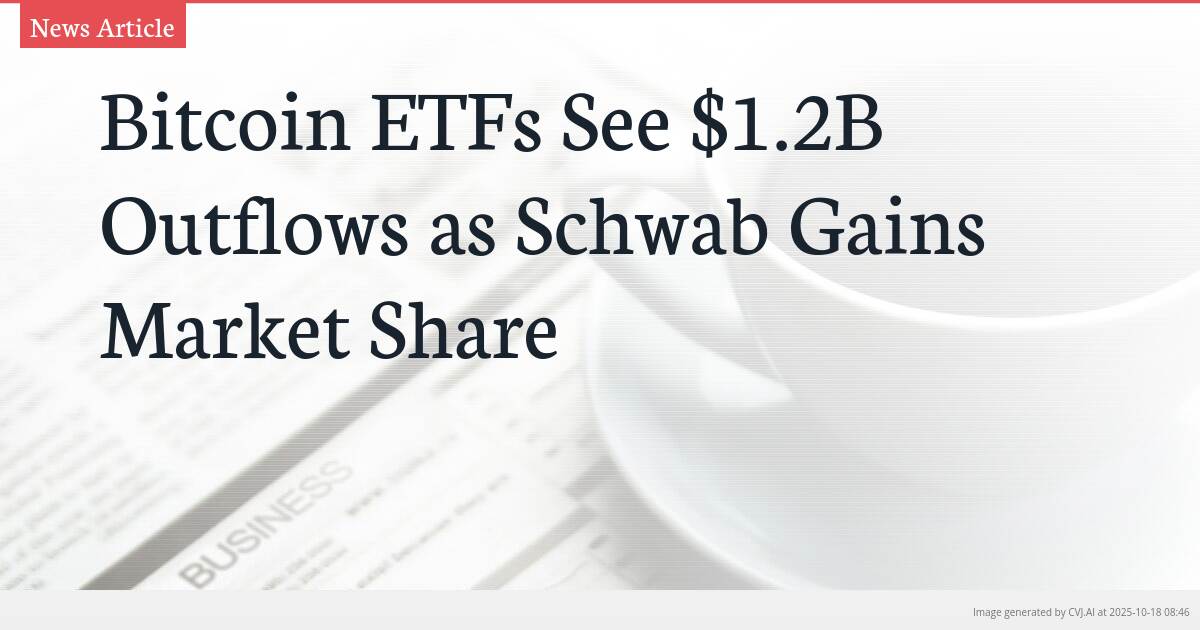This summary text is fully AI-generated and may therefore contain errors or be incomplete.
Introduction
Spot Bitcoin ETFs experienced massive outflows totaling $1.22 billion this week as BTC prices declined. Despite the sector-wide withdrawals, Charles Schwab reported its clients now hold 20% of all US crypto ETP assets, signaling shifting institutional adoption patterns amid market turbulence.
Key Points
- BlackRock's iShares Bitcoin Trust experienced the largest single-day outflow at $268.6 million on Friday
- Charles Schwab clients now control one-fifth of all US crypto ETP assets despite sector-wide outflows
- Eleven spot Bitcoin ETFs collectively saw $366.6 million in outflows on Friday, capping a difficult week for the asset class
A Week of Significant Outflows
The United States spot Bitcoin ETF market faced substantial pressure throughout the week, with the eleven approved funds collectively experiencing over $1.2 billion in outflows. The bleeding culminated on Friday with an aggregate outflow of $366.6 million, according to data from SoSoValue, rounding off what market analysts described as a ‘red week’ for Bitcoin-associated institutional investment products.
The consistent outflows occurred against a backdrop of declining Bitcoin prices, creating a challenging environment for the relatively new spot Bitcoin ETF products. The week’s performance highlights the sensitivity of institutional crypto investments to market volatility and price movements in the underlying asset. The data reveals a clear pattern of investor caution as Bitcoin’s price trajectory remained uncertain.
Major Players Lead the Exodus
BlackRock’s iShares Bitcoin Trust experienced the most significant single-day outflow on Friday, losing $268.6 million in assets. This substantial withdrawal from the world’s largest asset manager’s Bitcoin product represented the largest contributor to the day’s overall outflows and signaled growing caution among institutional investors.
Fidelity’s Bitcoin fund followed with $67.2 million in outflows, while Grayscale’s GBTC, which has been closely watched since its conversion from a trust to an ETF, saw $25 million exit the fund. Valkyrie’s ETF also experienced minor outflows, while the remaining spot Bitcoin ETFs recorded zero flows for the day. The distribution of outflows across multiple major providers indicates a broad-based retreat rather than isolated concerns about specific funds.
Schwab's Counterintuitive Success Story
Despite the sector-wide challenges, Charles Schwab reported that its clients now own 20% of all US crypto exchange-traded products. This surprising statistic emerges as a bright spot in an otherwise difficult week for crypto ETPs, suggesting that while some investors are pulling back, Schwab’s client base is maintaining or increasing exposure through the brokerage platform.
The contrast between Schwab’s growing market share and the broader outflow trend highlights the evolving nature of institutional crypto adoption. Schwab’s position indicates that certain investor segments continue to view crypto ETPs as valuable portfolio components, even during periods of market uncertainty. The data suggests that distribution channels and client demographics may play a significant role in determining investment behavior during volatile periods.
Implications for Institutional Crypto Adoption
The simultaneous occurrence of massive outflows and Schwab’s market share growth presents a complex picture of institutional crypto adoption. While the headline numbers point to significant investor retreat, the underlying data reveals more nuanced behavior patterns among different investor groups and distribution platforms.
The week’s events demonstrate that institutional interest in Bitcoin ETFs remains in flux, with investor sentiment closely tied to Bitcoin’s price performance. However, Schwab’s reported 20% market share suggests that established financial institutions are successfully integrating crypto products into their offerings and that a substantial portion of investors sees long-term value in maintaining exposure through regulated vehicles, even during market downturns.
📎 Read the original article on cointelegraph.com

